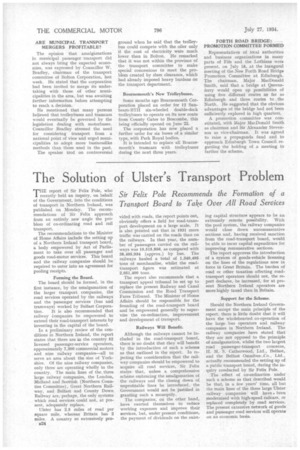ARE MUNICIPAL TRANSPORT MERGERS PROFITABLE?
Page 42

If you've noticed an error in this article please click here to report it so we can fix it.
The opinion that amalgamations in municipal passenger transport did not always bring the expected economies, was expressed by Councillor W. Bradley, chairman of the transport committee of Bolton Corporation, last week. He stated that the corporation had been invited to merge its undertaking with those of other municipalities in the area, but was awaiting further information before attempting to reach a decision.
He mentioned that many persons believed that trolleybuses and tramcars would eventually be governed by the legislation dealing with motorbuses. Councillor Bradley stressed the need for considering transport from a national point of view and urged municipalities to adopt more businesslike methods than those used in the past.
The speaker trod on controversial
ground when he said that the trolleybus could compete with the oiler only if the cost of electricity were much lower than in Bolton. He remarked that it was not within the province of the transport committee to make specialconcessions to meet the problem created by slum clearance, which had already imposed heavy burdens on the transport department.
Bournemouth's New Tr011eybuses.
Some months ago Bournemouth Corporation placed an order for 12 Sunbeam-BTII six-wheeled double-deck trolleybuses to operate on its new route from County Gates to Boscombe, this being officially opened on June 22.
The corporation has now placed a further order for six buses of a similar type, with Park Royal bodies.
It is intended to replace all Bournemouth's tramcars with trolleybuses during the next three years. FORTH ROAD BRIDGE: PROMOTION COMMITTEE FORMED Representatives of local authorities and business organizations in many parts of Fife and the Lothians were present, on July 18, at the inaugural meeting of the New Forth Road Bridge Promotion Committee at Edinburgh. The chairman, Major MacDonald Smith, said that a bridge at Queensferry would open up possibilities of using five different routes as far as Edinburgh and three routes to the North. He suggested that the obvious advantages of the bridge had not been sufficiently explored in high quarters.
A promotion committee was constituted, with Major MacDonald Smith as chairman and Sir Alexander Stevenson as vice-chairman. It was agreed to raise a propaganda fund and to approach Edinburgh Town Council regarding the holding of a meeting to further the scheme.




































































































